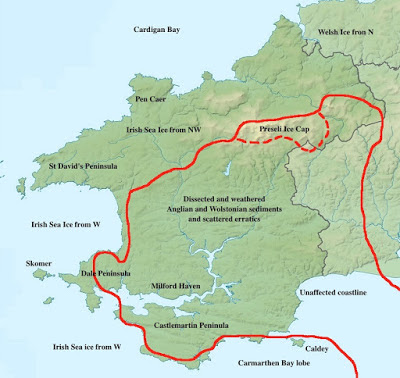I spent a long time wandering around on Waun Mawn and Cnwc yr Hydd yesterday, looking at those quarries -- and I am as mystified as ever. While I am implacably opposed to the idea that there is a "bluestone monolith quarry" at Rhosyfelin, these quarries are so obvious that nobody would seek to pretend that they were created by the forces of nature!
Grid ref: SN 083345
First, the facts. The geology map shows that the greater part of this area is underlain by Aber-mawr shales and mudstones of Ordovician age, with strips or sills or "microgabbro" (which is another word for dolerite, which is another word for diorite). But the hill mass appears to me not to be made of sedimentary rocks at all, but of rhyolites and ashes similar to the rocks to the east, in the Brynberian area. I think there may even be foliated rhyolites similar to those at Rhosyfelin -- I have some samples, and proper geological identification is needed. The rocks break up into slabs and flakes, and from the few rock exposures we can look at, there appears to be intense fracturing with multiple intersecting fractures. Where the dolerite outcrops, to the west of the hill summit, we see occasional slabs and rock projections up to 2m high, but the ground surface is covered for the most part with a dolerite blockfield, with thousands of weathered and abraded boulders and pillar-shaped stones lying about everywhere.
Foliated rhyolite outcropping in one of the quarry pits to the south of the summit
Part of the dolerite blockfield to the west of the summit. Bedrock outcrops and loose blocks, some showing signs of glacial abrasion and others broken by frost action
There are scores of quarrying pits, for the most part less than 2m deep and 5m across. In the most intensely quarried areas, the pits are so close together that the landscape has a "honeycombed" appearance, with intersecting pit edges, and with piles of spoil as well. The quarries are strung out over a distance of more than 500m, from the edge of the common in the north to near the edge of the "platform with stones" to the south. Maybe the quarrying activity has been concentrated on the junction between dolerite to the west and rhyolites and other volcanic rocks to the east?
There are five groups of quarries, and some outliers as well, as shown on the Bing satellite image above. Quarry 1 has an extent of 40m x 20m; Quarry 2 extends over an area of 30m x 30m; Quarry 3 is 100m x 50m in extent; Quarry 4 (around the hill summit) is 30m x 30m in extent; and Quarry 5 extends over an area of 150m x 30m. The total area covered by these quarrying activities is 12,100 square metres. This is truly quarrying on an industrial scale.
This is what the quarries look like in close-up:
So are the quarries really prehistoric? I really cannot tell. Part of me thinks that maybe they have been exploited for rubble for the building of the farm track between Tafarn y Bwlch and the farm called Gernos-fach. But if that was the case, one would expect more distinct trackways leading from the quarries and maybe signs of heavy machinery use -- but the only quarry that shows signs of "farmer exploitation" is quarry number 1, on the northern edge of the common. So let's keep a question mark about the formation of that one.
But quarry complexes 2-5 are utterly convincing. How old are they? Neolithic? Bronze Age? Iron Age? Medieval? Might they even be related to the presence of a deer park in this area between 1550 and 1750?
And what on earth were the quarries for? We can consider various options:
1. Were the quarrymen digging for rhyolite bluestone monoliths for the putative "proto-Stonehenge" on the platform on the south side of the hill? That's vanishingly unlikely, since the bedrock is flaky and heavily fractured, and does not break up into coherent large slabs or pillars. Not one of the standing stones or cromlechs in this area is made of flaky rhyolite, let alone Ordovician shales or mudstones -- the stone of choice ALWAYS appears to have been dolerite, if it was available. And here it was available, in great abundance.
2. Were they hunting for a rock type suitable for axe manufacture? That's a possibility, but the rock fragments visible at the surface today do not seem well suited since they are too flaky and do not fracture conchoidally.
3. Were they digging for disposable scrapers and cutting tools? Again, possible -- but could quarrying on this scale really have been undertaken for so mundane a purpose?
4. Might the diggers have been following a quartz vein and digging out white quartz for ornamental use as at Newgrange? Possible -- there are some rather spectacular quartz boulders in the area, including some projecting through the turf in the dolerite blockfield.
5. Might the pits have been dug in the Bronze Age in the hunt for mineral ores -- copper or tin, for example? Possible, but the diggers would probably not have found very much, since this area is not renowned for its rich mineral pickings.
The jury is still out on all of this -- all suggestions welcome! In the meantime, here are a few photos of what the pits and cuts look like on the ground:
PS. Another possibility comes to mind:
6. Might the diggers simply have been taking slabs of rock for building and / or roofing purposes? Did Bronze Age and Iron Age people use manageable slabs on the roofs of their structures to keep the weather out? Much more solid timbers would have been used to support the extra weight of slate or shale slabs, as compared with the structure needed to support thatch, but the extra investment in time and effort might well have been deemed worthwhile?




















































